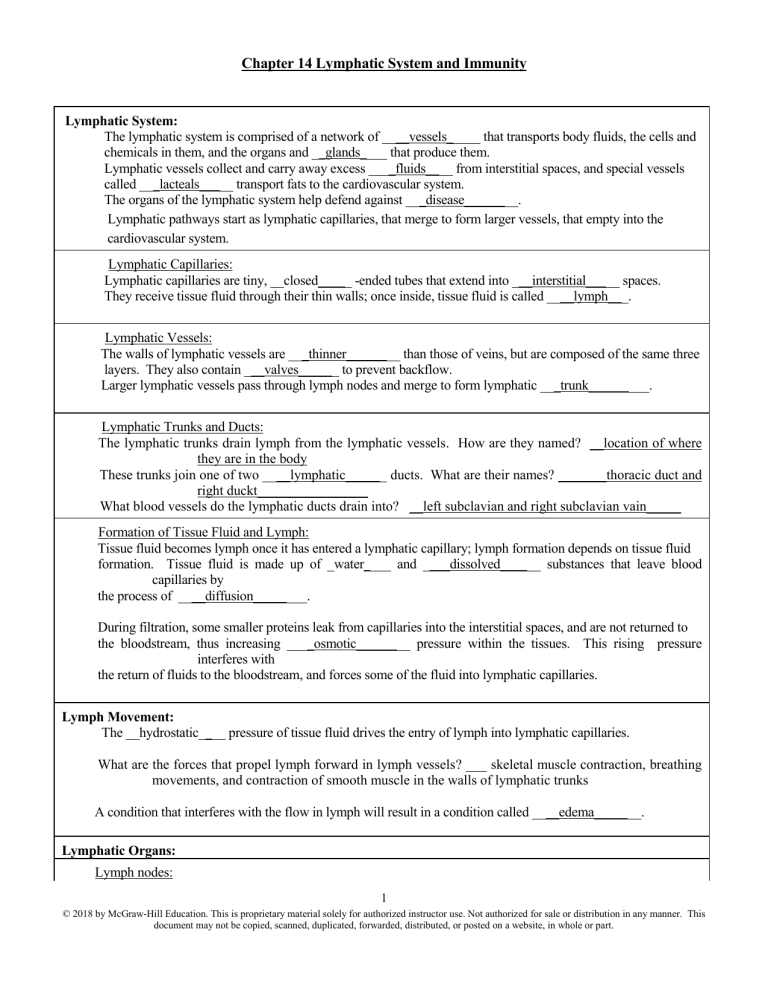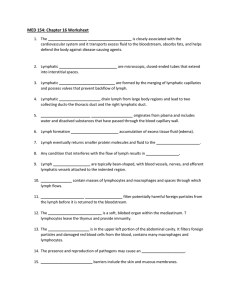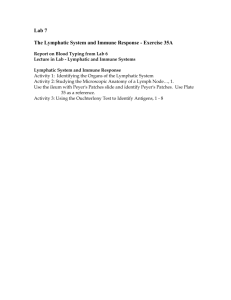
Chapter 14 Lymphatic System and Immunity Lymphatic System: The lymphatic system is comprised of a network of ____vessels_____ that transports body fluids, the cells and chemicals in them, and the organs and __glands____ that produce them. Lymphatic vessels collect and carry away excess ____fluids____ from interstitial spaces, and special vessels called ___lacteals_____ transport fats to the cardiovascular system. The organs of the lymphatic system help defend against ___disease________. Lymphatic pathways start as lymphatic capillaries, that merge to form larger vessels, that empty into the cardiovascular system. Lymphatic Capillaries: Lymphatic capillaries are tiny, __closed_____ -ended tubes that extend into ___interstitial_____ spaces. They receive tissue fluid through their thin walls; once inside, tissue fluid is called ____lymph___. Lymphatic Vessels: The walls of lymphatic vessels are ___thinner________ than those of veins, but are composed of the same three layers. They also contain ___valves______ to prevent backflow. Larger lymphatic vessels pass through lymph nodes and merge to form lymphatic ___trunk_________. Lymphatic Trunks and Ducts: The lymphatic trunks drain lymph from the lymphatic vessels. How are they named? __location of where they are in the body These trunks join one of two ____lymphatic______ ducts. What are their names? _______thoracic duct and right duckt________________ What blood vessels do the lymphatic ducts drain into? __left subclavian and right subclavian vain_____ Formation of Tissue Fluid and Lymph: Tissue fluid becomes lymph once it has entered a lymphatic capillary; lymph formation depends on tissue fluid formation. Tissue fluid is made up of _water____ and ____dissolved______ substances that leave blood capillaries by the process of ____diffusion________. During filtration, some smaller proteins leak from capillaries into the interstitial spaces, and are not returned to the bloodstream, thus increasing ____osmotic________ pressure within the tissues. This rising pressure interferes with the return of fluids to the bloodstream, and forces some of the fluid into lymphatic capillaries. Lymph Movement: The __hydrostatic____ pressure of tissue fluid drives the entry of lymph into lymphatic capillaries. What are the forces that propel lymph forward in lymph vessels? ___ skeletal muscle contraction, breathing movements, and contraction of smooth muscle in the walls of lymphatic trunks A condition that interferes with the flow in lymph will result in a condition called ____edema_______. Lymphatic Organs: Lymph nodes: 1 © 2018 by McGraw-Hill Education. This is proprietary material solely for authorized instructor use. Not authorized for sale or distribution in any manner. This document may not be copied, scanned, duplicated, forwarded, distributed, or posted on a website, in whole or part. In general, where are they located? __junctions of major lymphatic vessels such as the neck, groin, armpits_ Lymph nodes are __bean_______shaped, with blood vessels, nerves, and efferent lymphatic vessels attached to the indentation, called the ____helium__________, and with afferent lymphatic vessels entering on the convex surface. Lymph nodes are covered with ____connective_________ tissue, that extends inside the node and divides it into nodules and spaces called ____sinuses__. The nodes contain both ____lymphocytes______ and ___macrophages_______, which clean the lymph as it flows through the node. The white blood cells within lymph nodes filter _____lymph_____, and remove bacteria and cellular debris before it is returned to the blood. Lymph nodes are also centers of ____lymphocytes____ production; these cells function in immune surveillance. Thymus: The thymus is a soft, bi-lobed organ located behind the ___sternum______, which shrinks in size during the lifetime (large in children, microscopic in the elderly). The thymus is surrounded by a ___connective_____ tissue capsule that extends inward and divides it into __lobules__________. The lobules contain ____Lymphocytes___, some of which mature into __T____ cells (or T lymphocytes), that leave the thymus to provide immunity. The thymus secretes hormone called ___Thymosin___, which influences the maturation of T lymphocytes. Spleen: The spleen lies in the upper ____left____ ___abdominal___ cavity, and is the body’s largest lymphatic organ. The spleen resembles a large lymph node, except that it contains ___blood____ instead of lymph. Inside the spleen lies ___white___ pulp (containing many lymphocytes) and ____red___ pulp (containing red blood cells, macrophages, and lymphocytes). The spleen filters the ___blood___ and removes damaged blood cells and foreign particles. Body Defenses Against Infection: The body has two types of defenses against disease causing agents: ___non specific_____ or ___spcific_______ defenses that guard against any of them, and ___specific_ or ___non specific__ defenses (immunity) that mount a response against a very specific target. Any agent that causes infection or disease is called a ___pathogen_______. The first line of defense is a ___specific______ barrier, while the rest of the innate defenses are the __non specific_______ line of 2 © 2018 by McGraw-Hill Education. This is proprietary material solely for authorized instructor use. Not authorized for sale or distribution in any manner. This document may not be copied, scanned, duplicated, forwarded, distributed, or posted on a website, in whole or part. defense. Innate (Non-specific) Defenses: Describe the following types of nonspecific defenses: Species resistance: when a unique chemical environment or temperature cannot be tolerated by pathogens that might infect other species Mechanical barriers: non-specific defense when unbroken skin and mucous membranes prevent entry of many pathogens Chemical barriers: non-specific defense when many pathogens are killed by certain enzymes such as lysozyme, or by acidic or caustic environments Interferons: non-specific defense when there are peptide produced by cells when they are infected by viruses_ Inflammation: _ non-specific defense when a tissue response that brings increased blood flow and white blood cells into an area that has been invaded by pathogens Phagocytosis: _ non-specific defense when a process in which certain protective cells engulf and destroy pathogens?_ Fever: _When the body has a pathogen and the temperature rised to kill it Immunity (Adaptive or Specific Defenses): The body’s third line of defense, immunity refers to the response mounted by the body against specific, recognized foreign molecules. Antigen: Before birth, the body makes an inventory of "__self________" proteins and other large molecules. __Antigens___________ are generally larger molecules that elicit an immune response. Sometimes small molecules called ___haptens______ combine with larger molecules and become antigenic. Lymphocytes: During fetal development, ___red_______ bone marrow releases lymphocytes into the circulation, 70-80% of which become ____T ____ lymphocytes, and 20-30% of which become __B____ cells. Undifferentiated lymphocytes that reach the thymus become T cells; B cells are thought to mature in the bone marrow. Both B and T cells reside in lymphatic organs. T-Cells and the Cellular Immune Response (Cell Mediated Immunity): ______T_____ cells attack foreign, antigen-bearing cells, such as bacteria, by direct cell-to-cell contact, providing cell- mediated immunity. The activation of this cell requires the presence of an antigen-presenting cell, such as a B cell or a ___memeory______, which has already encountered the antigen. There are several kinds of T cells. 3 © 2018 by McGraw-Hill Education. This is proprietary material solely for authorized instructor use. Not authorized for sale or distribution in any manner. This document may not be copied, scanned, duplicated, forwarded, distributed, or posted on a website, in whole or part. In order for a ____helper____ T cell to become activated, it must first encounter an antigen-presenting cell displaying the antigen on its major _____histocompatability_____ complex (MHC) proteins; if the antigen fits the T cell's antigen receptors, it becomes activated and stimulates B cells to produce antibodies. ___cytoxic_____ T cells continually monitor the body's cells, recognizing and eliminating tumor cells and virus-infected cells by the release of proteins, cutting holes in cell membranes, and by other means. These T cells become activated when an antigen binds to their receptors. __memory_____ cells provide a no-delay response to any future exposure to the same antigen. B-Cells and the Humoral Immune Response (Antibody Mediated Immunity): A __B cell may become activated and produce a clone of cells when its antigen receptors encounter their matching antigen, but most of these cells need _Helper T cells for activation. When a helper T cell encounters a B cell that has already encountered the antigen, the helper T cell releases ___cytokines_____ that activate the B cell, so that it can divide and form a _____clone_____. Some of the new B cells become __Plasma_____ cells, producing and secreting _____antibodies_________. Other new B cells become ____memory__B______ cells, to respond to future encounters with the antigen. Types of Antibodies: There are five major types of antibodies (immunoglobulins) that constitute the gamma globulin fraction of the plasma. __IgG_____ is found in tissue fluid and plasma and defends against bacteria, viruses, and toxins and activates complement. ___IgA____ is found in exocrine gland secretions (breast milk, saliva, tears), and defends against bacteria and viruses. __IgD___ is found in plasma, activates complement, and reacts with red blood cells during transfusions. ____IgM____ is found on the surface of most B lymphocytes, and functions in B cell activation. _____IgE_____ is found in exocrine gland secretions, and promotes allergic reactions. Antibody Actions: Antibodies can react to antigens in three ways: what are they? Describe each method. Direct attack, activation of complement system, stimulate chemical changes. Primary & secondary immune responses: When B or T cells become activated the first time, their actions constitute a ___Primary_________ immune response, after which some cells remain as memory cells. If the same antigen is encountered again, more numerous memory cells can mount a more rapid response, known as the ____secondary__ immune response. The ability to produce a secondary immune response may be longlasting. In which case is the person most likely to become ill, when having a primary or secondary immune response? Why? Primary act a a memeory B cell Types of immunity: 4 © 2018 by McGraw-Hill Education. This is proprietary material solely for authorized instructor use. Not authorized for sale or distribution in any manner. This document may not be copied, scanned, duplicated, forwarded, distributed, or posted on a website, in whole or part. Describe and give an example of each of the following: Naturally acquired active immunity: _ result from development of antibodies in response to the presence of an antigen_ Naturally acquired passive immunity: _ aquired by the transfer of antibodies from another individual Artificially acquired active immunity: _ after exposure to antigen itself. 1st exposure to chicken pox_ Artificially acquired passive immunity: use of vaccines__ Allergic Reactions: Allergic reactions to ___allergens___________ are excessive immune responses that may lead to tissue damage. __immediate____-reaction allergy is derived from an inherited ability to overproduce _IgE__. During allergic reactions, ______Mast___ cells release ____D____, _____2____, and leukotrienes, producing a variety of effects. ___hypersensitivity__________-reaction allergy results from repeated exposure to substances that cause inflammatory reactions in the skin. This type of allergic response can occur in anyone. Transplantation and Tissue Rejection: A transplant recipient's immune system may react with foreign __attack________ on the surface of the transplanted tissue, causing a tissue ___negative_________ reaction. How can this reaction be reduced? _Medecine that blcosk the antigen receptors so the body does not attack the transplant but they are at risk of pathogens attacking them____________________________________________________________ Autoimmunity: In autoimmune disorders, the immune system manufactures antibodies against some of its _____own_______ antigens. What may cause this? No exact cause has been found but it seems that the body confuses it’s own body and attacks. Bacteria or viruses or drugs may trigger changes that confuse the immune system List some autoimmune disorders.MS, Lupus, rheumatoid arthritis 5 © 2018 by McGraw-Hill Education. This is proprietary material solely for authorized instructor use. Not authorized for sale or distribution in any manner. This document may not be copied, scanned, duplicated, forwarded, distributed, or posted on a website, in whole or part.




